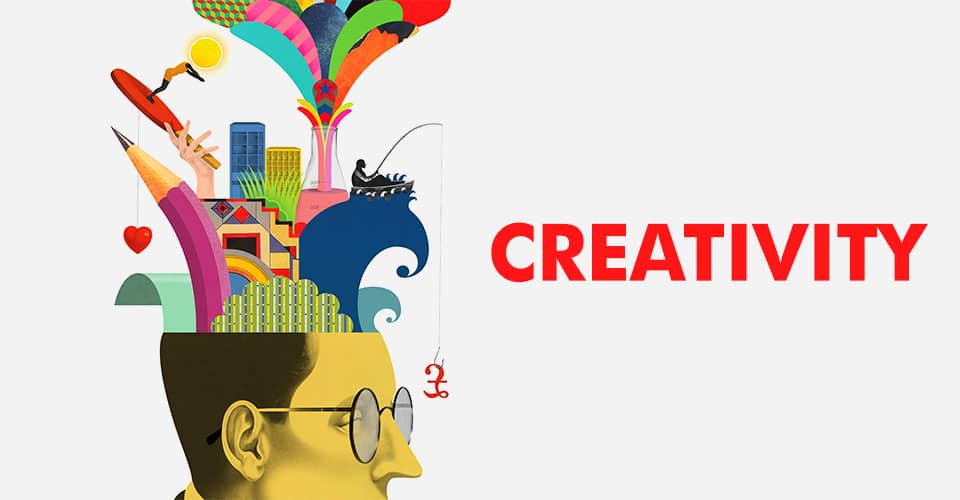Creativity is more than just a talent for painting, writing, or playing music. It is a cognitive and emotional process that helps us generate new and valuable ideas, think in unconventional ways, and turn imagination into reality. Whether it’s solving a problem, making something artistic, or approaching a task differently, creativity plays a crucial role in enhancing mental flexibility and overall well-being.
What is Creativity?
Creativity is a special skill 1 Runco M. A. (2004). Creativity. Annual review of psychology, 55, 657–687. https://doi.org/10.1146/annurev.psych.55.090902.141502 that allows us to come up with new and valuable ideas, think in unique ways, and turn our imagination into something real. It’s about using what we already know and our own experiences to create fresh solutions, express ourselves through art, and gain new perspectives of life.
Creativity is also strongly linked to our mental well-being 2 Fiori, M., Fischer, S., & Barabasch, A. (2022). Creativity is associated with higher well-being and more positive COVID-19 experience. Personality and Individual Differences, 194, 111646. https://doi.org/10.1016/j.paid.2022.111646 .
Engaging in creative activities, such as painting, writing, or playing music, provides an outlet to express emotions, reduce stress, and explore our sense of self.
It can help us deal with tough situations, process difficult emotions, and find comfort or a sense of purpose. It’s important to note that creativity is not limited to any gender, but research suggests 3 BAER, J., & KAUFMAN, J. C. (2008). Gender Differences in Creativity. The Journal of Creative Behavior, 42(2), 75–105. https://doi.org/10.1002/j.2162-6057.2008.tb01289.x that men are generally perceived to be more creative than women.
Mental Health and Creativity
Some benefits of creativity on mental health 4 Tan, C. Y., Chuah, C. Q., Lee, S. T., & Tan, C. S. (2021). Being Creative Makes You Happier: The Positive Effect of Creativity on Subjective Well-Being. International journal of environmental research and public health, 18(14), 7244. https://doi.org/10.3390/ijerph18147244 include:
- Engaging in creative activities, such as solving puzzles, painting, or writing stimulates the brain, leading to improved cognitive function and enhanced mental abilities.
- Research indicates that regular participation in creative endeavors can effectively lower the risk of developing dementia 5 Galassi, F., Merizzi, A., D’Amen, B., & Santini, S. (2022). Creativity and art therapies to promote healthy aging: A scoping review. Frontiers in psychology, 13, 906191. https://doi.org/10.3389/fpsyg.2022.906191 and age-related cognitive decline.
- Creative activities trigger the production of dopamine and endorphins, often referred to as “feel-good” chemicals. This natural response uplifts mood and fosters happiness.
- Embracing creativity can help to reduce the impact of stress, acting as a valuable outlet for promoting relaxation and inner peace.
- Creativity can provide a means of self-discovery, self-expression, and emotional release, thus aiding in combating feelings of sadness and hopelessness.
Read More About Stress Here
How Does The Creative Brain Work?
While creativity is a complex process involving multiple brain regions 6 Beaty R. E. (2020). The Creative Brain. Cerebrum : the Dana forum on brain science, 2020, cer-02-20. , several key areas play distinct roles in creative output:
- Prefrontal cortex, located at the front of the brain, helps us generate ideas, evaluate their feasibility, and make judgments about their value.
- Association areas, connect different sensory and cognitive areas of the brain, combine different concepts or ideas that fosters creativity.
- Temporal lobes, particularly the right hemisphere, are associated with creative thinking and artistic expression.
- Hippocampus helps in the creative process by recalling relevant information, experiences, and associations that can be used in problem-solving or generating new ideas.
- Dorsolateral prefrontal cortex enables us to switch between different strategies, overcome mental blocks, and inhibit habitual thinking, promoting innovation.
Mental Illness and Creativity
Some studies suggest a correlation between certain mental health conditions, such as bipolar disorder or schizophrenia 7 Johnson, S. L., Murray, G., Fredrickson, B., Youngstrom, E. A., Hinshaw, S., Bass, J. M., Deckersbach, T., Schooler, J., & Salloum, I. (2012).
Creativity and bipolar disorder: touched by fire or burning with questions?. Clinical psychology review, 32(1), 1–12. https://doi.org/10.1016/j.cpr.2011.10.001 , and increased creativity in some individuals. It is hypothesized that the altered thought patterns, heightened emotional states, or unique delusional perspectives associated with mental illness may contribute to unconventional and innovative thinking.
Read More About Bipolar Disorder Here
However, it is crucial to recognize that mental illness can also have adverse effects on creativity. Depressive and anxiety symptoms 8 Xu, Y., Shao, J., Zeng, W., Wu, X., Huang, D., Zeng, Y., & Wu, J. (2021). Depression and Creativity During COVID-19: Psychological Resilience as a Mediator and Deliberate Rumination as a Moderator. Frontiers in psychology, 12, 665961. https://doi.org/10.3389/fpsyg.2021.665961 such as lack of motivation, cognitive difficulties, or emotional instability can hinder creative processes and output.
Read More About Anxiety Here
Famous Artists with Mental Illness
Numerous famous artists throughout history 9 Pavitra, K. S., Chandrashekar, C. R., & Choudhury, P. (2007). Creativity and mental health: A profile of writers and musicians. Indian journal of psychiatry, 49(1), 34–43. https://doi.org/10.4103/0019-5545.31516 have been known to have experienced mental illness. Vincent van Gogh 10 Wolf P. (2001). Creativity and chronic disease. Vincent van Gogh (1853-1890).
The Western journal of medicine, 175(5), 348. https://doi.org/10.1136/ewjm.175.5.348 , renowned for his post-impressionist works, struggled with depression and is believed to have had bipolar disorder. Frida Kahlo 11 Budrys V. (2006). Neurological deficits in the life and works of Frida Kahlo. European neurology, 55(1), 4–10. https://doi.org/10.1159/000091136 , known for her surrealist self-portraits, coped with physical and emotional pain resulting from a severe bus accident and lived with depression.
Edvard Munch 12 Friedlaender, G. E., & Friedlaender, L. K. (2018). Edvard Munch and The Scream: A Cry for Help. Clinical orthopaedics and related research, 476(2), 200–202. https://doi.org/10.1007/s11999.0000000000000046 , the creator of the iconic painting “The Scream,” grappled with anxiety and panic attacks. These artists and others have left a lasting artistic legacy while navigating the complexities of mental health challenges.
Read More About Panic Disorder Here
The Role Of Creativity In Healing Mental Illness
Creativity works as a therapeutic approach 13 Galassi, F., Merizzi, A., D’Amen, B., & Santini, S. (2022). Creativity and art therapies to promote healthy aging: A scoping review. Frontiers in psychology, 13, 906191. https://doi.org/10.3389/fpsyg.2022.906191 for mental illness, which include:
- Art therapy, such as drawing, painting, or sculpting provides a non-verbal outlet for self-expression, promotes emotional processing.
- Music therapy, playing an instrument, or engaging in music composition can reduce anxiety, improve mood, and enhance self-esteem.
- Writing and journaling for self-reflection, processing of emotions, and gaining a sense of clarity can serve as a tool for coping and reducing stress.
- Dance and movement therapy promotes self-expression, body awareness, and emotional release, which can reduce symptoms traumatic experiences.
- Engaging in drama or theater activities can build social connections which has been shown to enhance self-confidence, communication skills, and emotional resilience.
- Participating in visual arts, like photography, encourages appreciation of surroundings, finding beauty in everyday life, and a sense of accomplishment.
- Engaging in craft activities such as sewing, knitting, or woodworking can serve as a distraction from negative thoughts and improve overall mood.
Read More About Music Therapy Here
Takeaway
The mental health benefits of creativity include reduced stress, improved mood, increased self-awareness, enhanced self-esteem, a sense of accomplishment, and greater emotional resilience.
Engaging in creative activities can provide individuals with a sense of empowerment, improved emotional well-being, and valuable coping mechanisms to navigate the challenges of mental health and illness.
At A Glance
- Creativity is a special skill that allows us to come up with new and valuable ideas, think in unique ways, and turn our imagination into something real.
- Engaging in creative activities, such as solving puzzles or writing stimulates the brain, leading to improved cognitive function and enhanced mental abilities.
- Parts of the brain such as Prefrontal cortex, hippocampus, and temporal lobe are connected with creativity.
- There is a positive and negative correlation between mental illness and creativity.
- Vincent van Gogh, Frida Kahlo are the examples of famous artists with mental illness who have left a lasting artistic legacy.
- Art therapy, music therapy etc. promote positive mental health and creativity.
Frequently Asked Questions (FAQs)
1. How can creativity be nurtured in children?
Creativity in children can be nurtured by providing opportunities for open-ended play, encouraging imagination, and valuing their unique ideas and desire for expressions.
2. Can creativity be influenced by external factors?
External factors such as the environment, culture, social support, and exposure to diverse stimuli can influence creativity.
3. Can creativity be learned?
Yes, engaging in creative activities, exploring new experiences, and embracing a mindset that values curiosity, experimentation, and risk-taking can enhance one’s creative thinking abilities.















